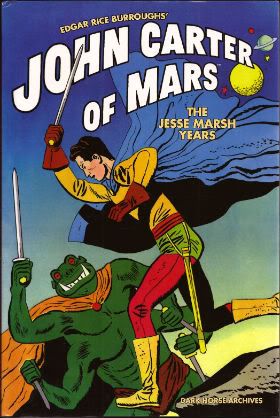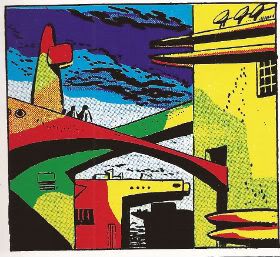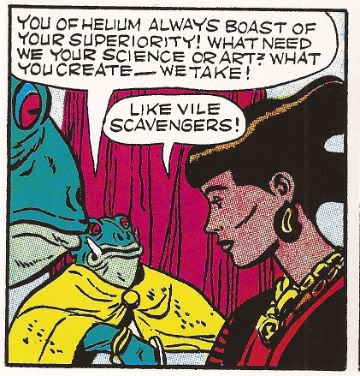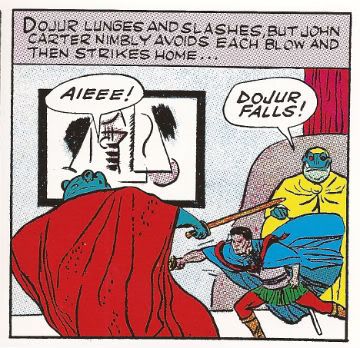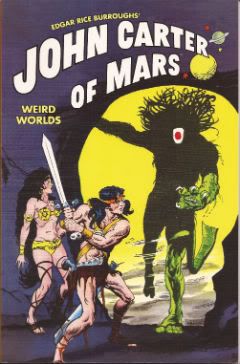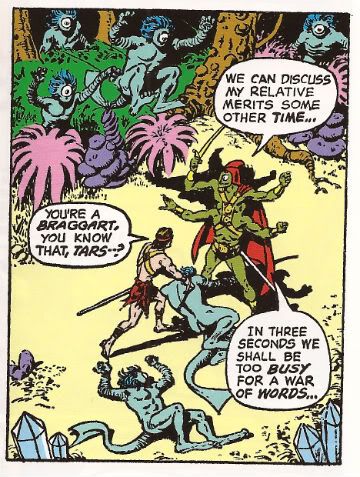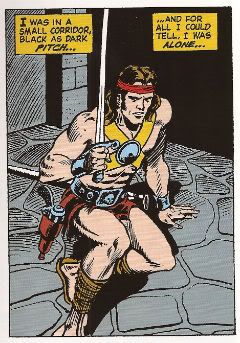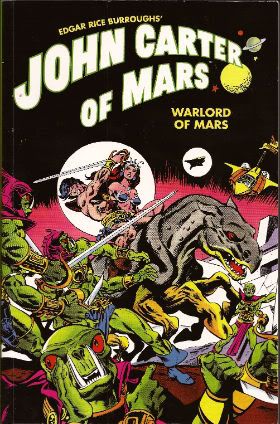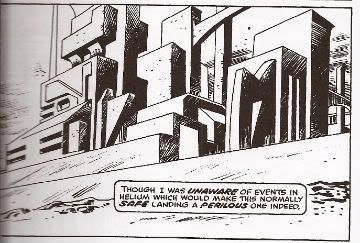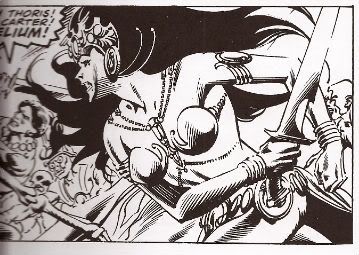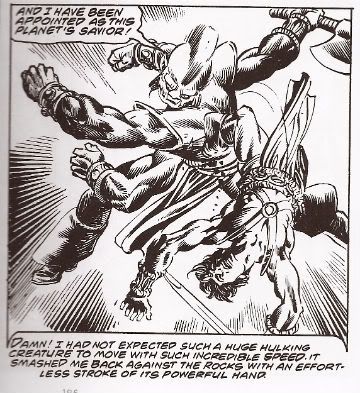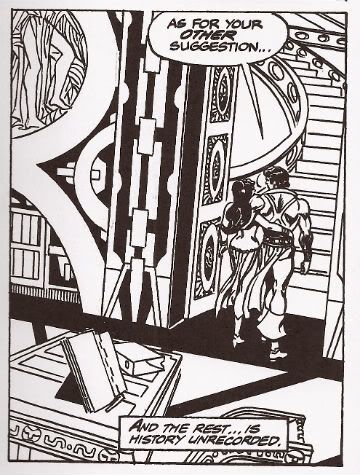"I'm A MAN, And I'll LOVE You As A Man Loves A ..." Comics! Sometimes There's A Film Out As Well! (John Carter!)
/So, yeah, there's a John Carter film out on Friday. Not that I ever get to the pictures anymore but, hey, you might! In the meantime you could read this about some comics featuring the same character. It's a thought isn't it. Probably one more than went into the writing of this. Hey, can CGI do this?:
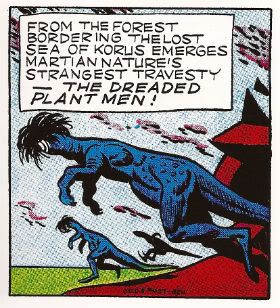
No, no it can not. You lose CGI!
I guess I should start with a disclaimer: I'm not really an Edgar Rice Burroughs fan; indeed I don't even know if I have read the source novels for these comics. So if you're looking for an informed Burroughsian monograph you might want to jump off right here. What follows is just some old gimp prattling about some comics, because what he really likes is comics. And prattling.
EDGAR RICE BURROUGHS’ JOHN CARTER OF MARS: THE JESSE MARSH YEARS Drawn by Jesse Marsh. Scripted by Paul S. Newman. Foreword by Mario Henandez. Collects Four Color Comics #375, #437 and #488, originally published in 1952 and 1953 by Dell Publishing Co., inc. (Dark Horse Books, 2010, $29.99)
I bought this book because once I'd seen the cover it refused to entirely leave my mind and was constantly hovering there urgently pressing me to purchase it at some point. I think it was the really solid no-nonsense blacks that fixed the image to the page and into my mind. At the time I had been admiring Don Heck's solid blacks and this seemed to play off and feed into that brief flare of interest. Also, there was something very Gilbert Hernandez about it what with the intentionally(?) stilted poses , the harsh crease lines and the occasional smattering of dots for texture. So I bought the book with some Christmas money and prepared to be disappointed. Obviously the cover was just a lucky image that Dark Horse were using to lure credulous punters like myself into buying reprints of justly forgotten chaff as the Hollywood version of the material slowly hove into view.
I was wrong.
Mars circa 1952.
This book was fantastic. Jesse Marsh is fantastic. This isn't actually news to anyone except me it seems. He's actually on the list of possible inductees into the 2012 Eisner's Hall of Fame. Casting my mind back I recall interviews with Alex Toth and Howard Victor Chaykin (who is also on the 2012 Hall of Fame list. What a dilemma!) in which both mention Jesse Marsh. Still, it's one thing hearing about a comic artist's work and seeing it.
Actually looking at it Marsh's work looks totally ahead of its time. Wait, let's back up. I'm not saying anyone could mistake these comics for modern comics. The very nature of the material works against Marsh in this regard. For a start each of the three reprinted comics are tasked with adapting an entire Edgar Rice Burroughs' novel in 32 pages. There's no time for shilly-shallying, no room for indulgences like splash pages, very little chance for a panel's art to be unadorned by narration or dialogue. No, Marsh has to fit it all in to a series of pages consisting of (roughly) 6x6 grids where his greatest indulgence is to let two such panels bleed together either vertically or horizontally. And he doesn't get to do that all that often. Cramped and constricted as he is by the format Marsh has the technique to deliver the equivalent of putting on a musical in an elevator. That's where the 'ahead of its time' bit comes in; in the actual art.
The Incomporable Dejah Thoris - Circa 1952.
There's a colossally impressive understanding of design on show. Because Marsh is working in the highly strictured world of '50s comics (and Gold Key were particularly inflexible in format) Marsh is unable to do anything about the actual page design but the design of the panels themselves are beautifully chosen to balance the elements within them. And (get this) the actual elements within the panels are further forays into design by an artist who was clearly just so incredibly good at what he did he could do the incredible just to keep himself amused. What other reason can there be for the pictures/sculptures/scenery with which Marsh surrounds his characters? His sculptures and pictures are so good I have the suspicion that they are actual object d'art that only my lack of breeding and education prevent me from identifying. The fact they change from panel to panel (even when the scene has not changed!) suggest Marsh was just larking about. But, what larks!
Martian Action! Circa 1952.
But, no, you aren't going to mistake these comics for the cutting edge of Now. Marsh's work does have its failings but although the characters may be stiff it must be said they are distinctive. The "incomparable" Dejah Thoris seems to have been modelled on the actor Emily Watson which can't be right? John Carter isn't terribly expressive but he does look like himself in every scene and doesn't look like anyone else and you can't always say that about even modern comics. Although the big thing everyone gets sweaty about with Burrough's Mars novels is that everyone is nudey rude except for weapons and jewelry everyone here is fully dressed. So, I guess purist might balk but all the incident, adventure and momentum of good pulp entertainment remain intact. Given the task of illustrating the functional script of Paul S. Newman Marsh manages to not only provide work which does so but at the same time carves out room to indulge his own idiosyncrasies and interests in a way which actually serves to enhance the work rather than distract or undermine its primary purpose: to entertain.
John Carter circa 1952.
One for the folks interested in form rather than content, or the talent rather than the character if you like. VERY GOOD!
EDGAR RICE BURROUGHS’ JOHN CARTER OF MARS: WEIRD WORLDS Art by Sal Amendola, Murphy Anderson, Gray Morrow and Joe Orlando. Written by Marv Wolfman. Introduction by Marv Wolfman. Collects stories from Tarzan #207-209 and Weird Worlds #1-#7, originally published in 1972 and 1973 by DC Comics. (Dark Horse Books, 2011, $14.99)
In 1971 as a hedge against the possibility that super-heroes had outstayed their welcome DC comics cast about for properties to replace them. Tarzan and the other ERB properties, including John Carter, caught DC's fancy since they were still adventure themed but more sober in appearance than super-heroes. This tells us that people are always predicting the end of super-hero comics and sobriety is pretty subjective. Good news for drunks, then! Great news for The Incomparable Joe Kubert who took the lead on the project. While his creative talents were focused on Tarzan he took on editorial duties for the other ERB character, such as John Carter. According to Bill Schelly's Man of Rock: A Biography of Joe Kubert (which I am filleting facts from in an attempt to look knowledgeable) Murphy Anderson and Marv Wolfman got the John Carter assignment because they were big John Carter fans. Apparently Michael William Kaluta wanted the gig but Murphy Anderson got it, mostly because he shared an office with Pappy Joe Kubert and was asked first. Not exactly high drama but that's what happened. (You could have guessed Granite Joe Kubert had edited these stories because he can't help sticking his inky fingers in the Gray Morrow chapter on on pg17-22.) Anyway, the comics that resulted are collected in this book.
Mars circa 1972.
Given the fact that fully two decades separate the work in this volume and that contained in the Marsh volume discussed earlier it's interesting to see how the comic art approach has changed. There's a lot more variety in page design in 1971 with panels inset into double page splashes, flashback panels with wobbly edges, decorative chapter headings a la old timey newspaper strips and on and on. What's clear is that the artist has far more freedom to control the visual presentation of the material. In between Marsh and Anderson's work something new has appeared: pacing. There is no pacing in the Marsh book; there's no opportunity for it. But in this volume it's evident that the writer/artist are able to actually pace their material. The material may have set limits as to length but these limits are far more generous than those Marsh was labouring under.
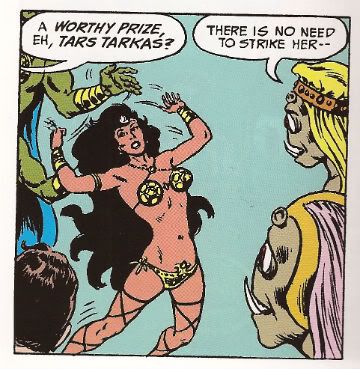 The Incomparable Dejah Thoris circa 1972.
The Incomparable Dejah Thoris circa 1972.
There's also a lot more freedom with regards to sex'n'violence. In the '50s material the incomparable Dejah Thoris was wrapped up like a shoolmarm but by the '70s she's certainly giving herself a good airing. Don't worry though because in the '50s John Carter was decked out like a Hussar but by the '70s he's all raggedy loincloth and musky muscles so noone's playing favourites here. Poor old Jesse Marsh had at best a couple of panels to depict savage action on worlds unknown but Anderson et al fare better with plenty of room to swing a Thark.
Martian Action! Circa 1972.
The ERB books didn't really sell very well and after a while moves were made to bring in cheaper foreign artists which probably explains why Murphy Anderson's contributions stop on pg. 68 and Sal Amendola finishes off the rest of the book. I'm not saying Sal Amendola was foreign (to American shores) but I am betting he was cheaper. After the somewhat traditional art preceding it the book suddenly explodes into a Barbarellatastic mindmelt of groovy layouts and gear designs, man. Well, it tries to. Alas, Sal Amedola is hampered by a lack of talent but the surfeit of ambition he possesses almost overcomes this. I said "almost". It isn't very pretty but I admire the energy; that's about as good as it gets with the Sal Amendola stuff. He does, however, chuck in some nudey rudery for the hardcore Burroughs' fans which is amusingly cheeky of him.
John Carter circa 1972.
As a complete TPB this one disappoints in that it starts off with some strong and solid work by industry vets but is compromised halfway through by market considerations to ultimatley produce a collection that I can only call OKAY!
EDGAR RICE BURROUGHS’ JOHN CARTER OF MARS: WARLORD OF MARS Art by Ross Andru, Bob Budiansky, Sal Buscema, Ernie Chan, Dave Cockrum, Ernie Colon, Frank Giacoia, Larry Hama, Carmine Infantino, Gil Kane, Bob McLeod, Frank Miller, George Perez, Walt Simonson, Mike Vosburg and Alan Weiss. Words by Chris Claremont, Peter Gillis, Bill Mantlo, Alan Weiss and Marv Wolfman Foreword by Michael Chabon Collects John Carter, Warlord of Mars #1-#28 and Annuals #1-#3 originally published in 1977-79 by Marvel Comics. (Dark Horse Books, 2011, $29.99)
Pulp got Gil Kane early and pulp got Gil Kane but good. Although he was often opining that Comics needed to mature itself in terms of subject matter, he, himself, was never able to escape the grip pulp held on his imagination. Gil Kane was a great, great man but his tastes could tend to the unsophisticated. Luckily since that was the very problem he berated comics for he may have been held back creatively but it didn't hurt him commercially. Particularly in the '70s when pulp's stock was strong in the comics market and he had plenty of juice himself.
Mars circa 1977.
In the '70s Kane spent a lot of time working up books he'd be interested in doing, starting them, realising he couldn't produce pages fast enough to pay him enough, leave the book, work up a book he's be interested in doing...and rinse, repeat. He was like the goddamn Littlest Hobo of comics or something ("There’s a voice that keeps on calling me. Down the road is where I’ll always be"). I'm being 'exasperated' because that behaviour makes it really hard to get good long runs of his stuff in collections. Obviously I know that's really not any concern of Gil Kane but equally obviously it does mean I'm glad to have this volume.
The Incomparable Dejah Thoris circa 1977.
So, yeah, my primary interest in this volume is the Gil Kane stuff. That's a good 190 pages. After that my attention started to wander a bit but I can assure you that the Gil Kane on these pages is some good Gil. As usual his natural glory is clothed by inks by someone else which isn't ideal but hardly a deal breaker. Most of the time the inks are by Rudy Nebres or other Filipino artists of the period. Which is fine as this lends everything an ornate quality appropriate to the pulp material. It helps make up for Kane's shortcomings. Oh, I love old Gil I do, I do but he did suffer from visual generalisation quite a bit. C'mon, we speak freely here; his future buildings and his ancient buildings are only distinguishable because the latter have some cracks in and a tree growing out of a window while the former doesn't. So, while it's usual to bemoan the fact it isn't Kane on Kane action for this volume it works out okay; the ripe inking lends everything a distinctive character Kane would probably have omitted if left to his own devices.
Martian Action! Circa 1977.
Where Kane doesn't need any help is in portraying the supple violence of well honed bodies in motion, communicating the lusty allure of his sexy ladies and his even more alluring men and basically creating such an atmosphere of raw physicality that it practically removes the readers glasses and tells them they are beautiful. Or something. I like Gil Kane's art, it sends me. Of course like any good bad boy he's gone when he's had his fill and Kane's departure makes the book stumble a little but the continued use of Rudy Nebres gives it enough visual continuity to keep it upright and interesting. For a while anyway. Storywise it's just the usual pulp stuff. In that it's more important that things happen than that the things that happen actually make sense. In fact the more outlandish and sense defying the better. The Headmen of Mars by Bill Mantlo and Ernie Chan is a particularly proud erection to the joys of sheer momentum and excess over intellect. It's pulp and it's written as such so the words don't treally bear close examination. Ah, but that's what they want you to think. If, however, you do pay attention to the words you find that EDGAR RICE BURROUGHS’ JOHN CARTER OF MARS: WARLORD OF MARS is in fact lubricated with sly innuendo and at times this reaches such steamy excess that it wouldn't be too great a surprise if the pages dilated at the touch of your enquiring fingers or let loose a soft sigh at the insistent pressure of your questing gaze.
I'm not joking. Not only are John Carter and the Incomparable Dejah Thoris continually on their way to/from the boudoir but you get the impression that if it weren't for all these Master Assassins of Mars, zombie hordes, air-pirates of Mars etc. they would be quite happy just letting John Carter make good on all his multiple breathy promises to "love her as only a husband can love a wife", "kiss her as she has never been kissed before" and "get right in there and root around like a monkey looking for nuts". This reaches delirious heights on p. 306 when the text reads:
"With a SKILL that still occasionally SURPRISES me--I MATCHED course and speed with Dejah's flier and DOCKED the two craft together. A moment later I was at her ENTRY HATCH--With a cry torn from her SOUL, she sprang into my arms --I will not DWELL on what happened next."
Oh, do dwell, Chris Claremont, dwell!
John Carter circa 1977.
And you know what? That's great! The John Carter and The Incomparable Dejah Thoris actually resemble a couple with a working sexual attraction. Okay, it might be somewhat exaggerated in a pulp stylee but maybe if my muscles were three times as powerful as any other males I imagine I'd be a lot more popular too.
I really liked this book but I think I've made it clear that that that's primarily because of the presence of Gil Kane, a tendency for my own interests to run to the unsophisticated and an appreciation for healthy smut. If you do not share these pleasures you probably won't find this to be GOOD!
(Apparently Marvel have released the same comics in a colour over-sized Omnibus. They are probably even better in colour. Sighhhhhhh.)
Mars. The Incomparable Dejah Thoris. John Carter. ('Mars Action' about to occur) circa 1977.
Have a good weekend and remember to read some COMICS!!!


